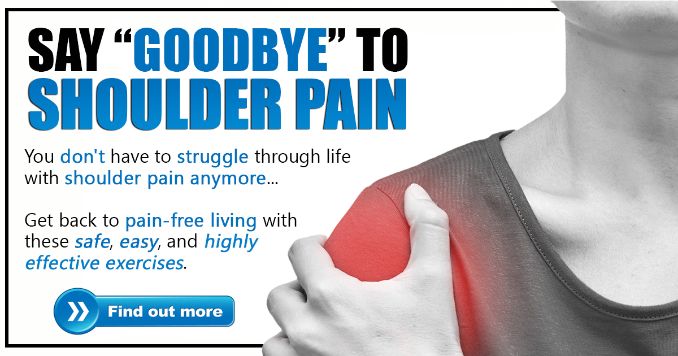Anatomy of the Shoulder: Most people never even think about the amazing properties of the human shoulder. It’s probably the most dynamic joint in your entire body since no other joint has such a wide range of motion. Let’s look inside this incredible mechanical wonder. Plus, we’ll learn about the most common shoulder ailments and how to identify and treat them.

Bones and Connectors
Your shoulder is a ball-and-socket joint made up of three bones: the clavicle (collarbone), scapula (shoulder blade) and humerus (upper arm bone). Several structures hold the bones together. Fibrous sheaths that connect bone to bone are called ligaments. Fibers that connect bone to muscle are called tendons. Layers of cartilage are located on bone-to-bone surfaces to allow for smooth motion.
There are also two soft sacs (the bursae) in the joint that cushion the shoulder and help to keep movement smooth. Also, your shoulder is surrounded by muscles and fibers, which are collectively called the rotator cuff. Finally, the entire shoulder has various nerves and blood vessels running throughout.
Wide Range of Movement
The intricate design of your shoulder joint allows for 360 degrees of rotation and 180 degrees of lateral arm movement in various planes. The 180 degrees actually goes a bit farther when you reach across your body or behind your back. Even though your shoulder is fairly sturdy, the wide range of movement makes the joint susceptible to injury.
How Do I Know if My Shoulder is Dislocated?
Anatomy of the Shoulder: Shoulder dislocation typically occurs after an impact or fall. In some cases, it’s very obvious that you’ve dislocated your shoulder since it looks much different than the other side. You might also notice the shoulder is swollen or bruised. Movement typically causes intense pain. Whatever you do, don’t try to “pop” your shoulder back into place. There are many nerves and blood vessels in the joint that could get damaged if you attempt this. Instead, put some ice on it and get medical attention right away.
A skilled surgeon can sometimes maneuver your shoulder back into place. This is called a “closed reduction.” Because this can be quite painful, you may need pain medication or a sedative during the procedure. Once your shoulder has been dislocated, the joint has been weakened and future dislocations are more likely. If your doctor can’t perform a closed reduction, or if you have repeated dislocations, you may require surgery to repair and strengthen the joint.
After any shoulder dislocation or surgery, you’ll likely undergo physical therapy to restore strength and range of motion.
What is Shoulder Bursitis?
Anatomy of the Shoulder: Returning to the shoulder anatomy, you might recall we mentioned two sacks found in the shoulder called the bursae. These are like balloons loosely filled with fluid to help cushion and smooth out shoulder movement. If for any reason a bursa gets irritated, it can lead to bursitis. This means there is inflammation and swelling, and you might notice the shoulder is tender on the outside. The cause of shoulder bursitis is typically due to injury or overuse.
The treatment for bursitis includes rest, physical therapy and anti-inflammatory medications. In more severe cases, the bursa might have to be drained or injected with steroids.
Less commonly, a shoulder joint bursa can get infected leading to a condition called septic bursitis. However, this usually occurs in people who have other health problems, such as cancer, immune deficiency, HIV, lung disease or chronic obstructive pulmonary disease (COPD) or diabetes. Antibiotics are required to treat septic bursitis.
What About Shoulder Tendonitis and Rotator Cuff Tendonitis?
The shoulder has several tendons that can get irritated and inflamed leading to tendonitis. The rotator cuff is a group of muscles and tendons that surround the shoulder. This provides movement and joint stability. Rotator cuff tendonitis can occur with age, injury or overuse.
It’s important to get treatment for rotator cuff tendonitis sooner than later. Delay in treatment could lead to weakness or stiffness. One very severe complication could be a frozen shoulder. This happens when you have a progressive loss of range of motion until you are left with nearly zero shoulder mobility. Recovery from a frozen shoulder is typically prolonged and painful.
The symptoms of rotator cuff tendonitis include:
- Shoulder swelling and tenderness especially at the front
- Clicking or grinding sensation when you raise your arms
- Shoulder weakness
- Reduced range of motion
The diagnosis of rotator cuff tendonitis is made by a doctor’s physical exam. Some physicians order an MRI scan to verify the diagnosis. Treatment includes anti-inflammatory medications and physical therapy.

What about Rotator Cuff Tears?
Rotator cuff tendonitis and rotator cuff tears might look very much alike symptom-wise. Tears might also be associated with a deep shoulder ache as well as difficulty sleeping. You could also have a rotator cuff tear and tendonitis simultaneously.
Moreover, any job or activity that requires repetitive arm motion might lead to a torn rotator cuff. Trauma or falls can also cause a tear. The diagnosis of rotator cuff tear is made by physical exam, X-rays, ultrasound, and MRI scan. Treatment is similar to rotator cuff tendonitis, but with a rotator cuff tear, you may need surgery.
What is Shoulder Impingement Syndrome?
Shoulder impingement occurs when the bones of the shoulder pinch a tendon or bursa. This condition is common among people who do repetitive movements above their heads like tennis players, painters and swimmers. The pain is pretty much constant and gets worse when you reach behind your back, above your head or move your arm to put on a coat. Moreover, impingement may lead to rotator cuff tear, tendonitis or bursitis if not treated properly.
Much like other shoulder problems, the treatment for shoulder impingement is rest, anti-inflammatory medications, and physical therapy, if needed.
How Do I Know if I Have Shoulder Arthritis?
Several different kinds of arthritis | 404 can affect the shoulder. Some of these are:
- Osteoarthritis: The most common type and more prevalent with age; it’s arthritis of “wear and tear” caused by cartilage breakdown and/or bone spurs
- Rheumatoid arthritis: An autoimmune disease that affects joints and many other body systems like the skin, eyes, lungs, and heart and requires treatment by a specialist
- Post-traumatic arthritis: Occurs after a shoulder injury; symptoms may appear years after trauma to the joint.
- Avascular necrosis: A rare disorder that occurs when your humerus doesn’t get enough blood; can be associated with shoulder dislocations and fractures, and bone cell death leads to worsening pain
Each of these types of arthritis is very different in its cause and treatment, although osteoarthritis and post-traumatic arthritis are fairly similar. The diagnosis and treatment vary and a joint specialist should be consulted. Since rheumatoid arthritis is a systemic disease, the treatment is even more specialized and goes beyond just treating the affected joints.

What About Shoulder Injections and Replacement?
In some cases, shoulder pain doesn’t respond to conservative treatment. Doctors sometimes resort to shoulder injections with steroids to provide symptom relief. However, steroid injections typically don’t lead to a permanent solution. Plus, steroids can cause bone damage and even avascular necrosis in rare cases. For these reasons, steroid injections for the shoulder joint are limited to three total per joint.
When shoulder pain or function is severely compromised, joint replacement surgery might be an option. Moreover, this often involves replacing the “ball-and-socket” part of the shoulder joint with a prosthetic. Furthermore, special plastics and metals (titanium) are used for maximum durability, lightweight and minimal chance of infection.
The rule of thumb is that a prosthetic shoulder joint lasts about 15 years. However, this might be an underestimation, since newer materials and techniques might increase the durability significantly.
When It’s Not Just Shoulder Pain — Beware
Remember, shoulder pain could be due to heart problems and not involve the joint at all. If you have shoulder pain when you walk or exercise, see a doctor right away. Other symptoms to look out for are shortness of breath, nausea, cold sweats, chest pain, or pain that radiates to the neck or back.
If you want to heal, lengthen and strengthen the muscles and tendons near your shoulders, loosen your shoulder joint and reshape your shoulder, so you can reduce and eliminate your shoulder pain and prevent it from occurring again in the future, then check out the Shoulder Pain Solved program, here!


